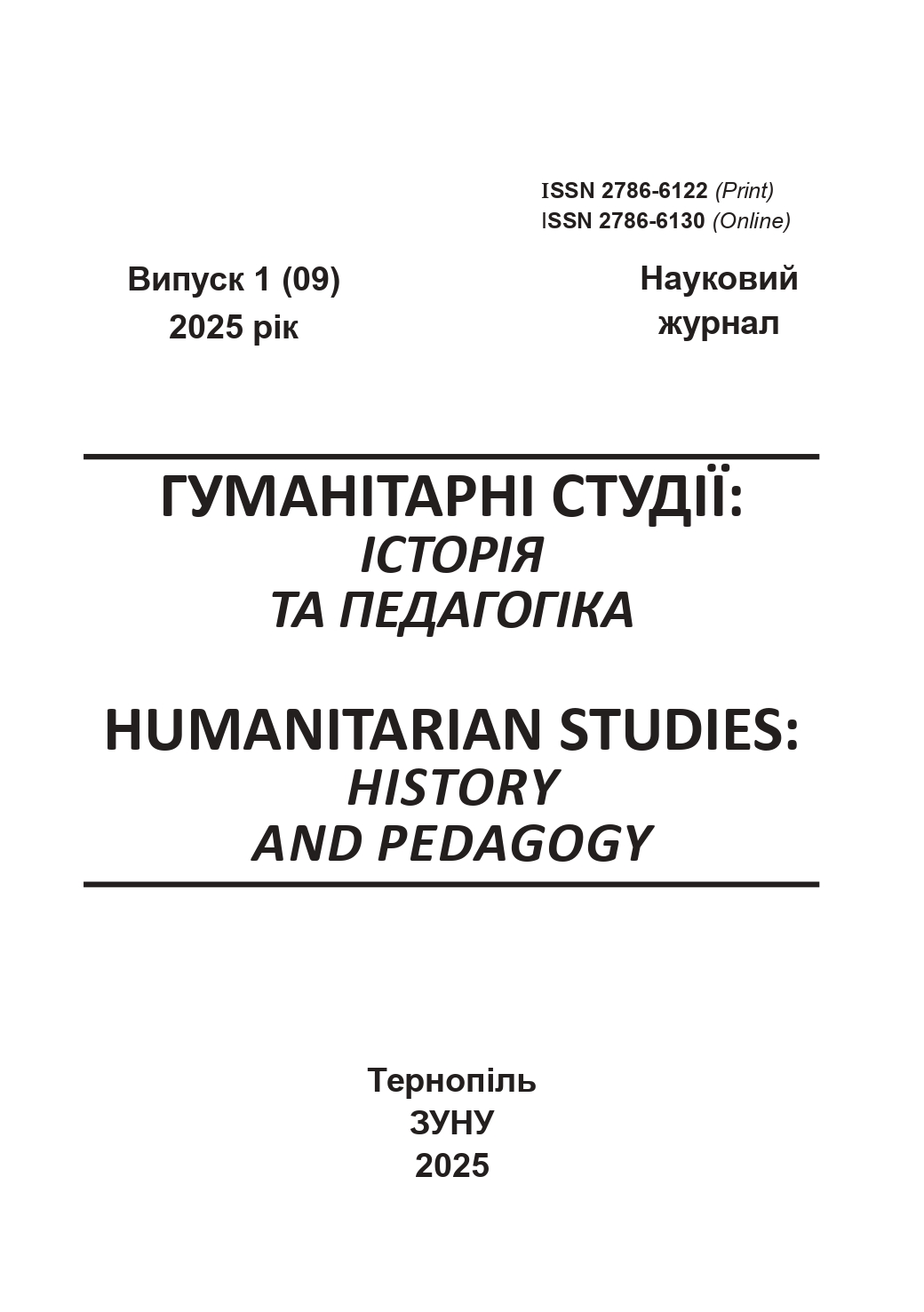ORGANIZATION OF EDUCATION DURING THE SOVIET-GERMAN WAR: CHALLENGES AND ADAPTATION (USING THE EXAMPLE OF KREMENECH REGION)
DOI:
https://doi.org/10.35774/gsip2025.01.102Keywords:
educational policy, Soviet-German war, District Commissariat of Ukraine, folk (primary) and vocational (vocational) schools, teachers, Kremenets region, civic competenceAbstract
The article highlights the state of development of education during the years of German occupation using the example of the functioning of schools in the Kremenets region (1941–1944). Emphasis is placed on the fact that the Nazi occupation policy was based on the Nazi ideological doctrine of the colonial destiny of Eastern Europe, therefore the authorities allowed only primary public schools to be opened and generally supported the development of vocational education, which was aimed at training workers for the industry and agriculture of the Third Reich.
The purpose of the study is to analyze the features of the establishment of the educational process during the Soviet-German war using the example of the Kremenets region, while identifying the main challenges faced by teachers and students, and outlining what contributed to the formation of civic competence of young people in the conditions of wartime hardship.
An analysis of the activities of Ukrainian schools during the study period was conducted, which shows that the community, despite the lack of teachers, textbooks, insufficient material resources and difficult conditions for teachers, and low salaries, managed to create a network of primary and vocational schools in the Kremenets district. We found that a significant challenge for educational institutions was the lack of funding, which led to the cessation of school activities. The way out of the situation was the organization of cooperatives at schools based on charitable and membership contributions. The activities of the cooperative at the Kremenets vocational trade school, which provided teachers and students with stationery and food, were exemplary.
In the publication, the authors emphasized the importance of the activities of the Organization of Ukrainian Nationalists (OUN(Revolutionary) in schooling, in particular its efforts to develop Ukrainian education and culture with national content. Underground classes on national education were held at a forest school in Bilokrynytsia, Kremenets district. In fact, this contributed to the formation of civic qualities in young people.
It is concluded that the Nazi occupation authorities in the field of schooling in Kremenets, District Commissariat of Ukraine, carried out a strict colonial policy, which was aimed at providing Ukrainians with only primary and vocational education. The study contributes to a better understanding of the impact of the war on the educational process in the current conditions of martial law in Ukraine.
The article uses documents and materials from the Kremenets Museum of Local Lore and the State Archives of Ternopil Region.
References
Hinda V. Osvitnia polityka natsystiv v Raikhskomisariati «Ukraina». [The educational policy of the Nazis in the Reichskommissariat «Ukraine»] Storinky voiennoi istorii Ukrainy. 2012. vol. 15. pp. 61–75. URL: http://nbuv.gov.ua/UJRN/Sviur_2012_15_7 (in Ukrainian).
Hordiienko V. Osvita i kultura v Ukraini v umovakh natsystskoi okupatsii. [Education and culture in Ukraine under Nazi occupation.] Hileia : naukovyi visnyk : zbirnyk naukovykh prats / hol. red. V.M. Vashkevych. K. : Vydavnytstvo «Hileia», 2015. vol. 92 (1). pp. 47–52 (in Ukrainian).
Derzharkhiv Ternopilskoi oblasti (DATO). F. R-199. Kremenetska miska serednia torhova shkola miskoi upravy Kremenetskoho okruhu. [Kremenets City Secondary Trade School of the City Administration of Kremenets District.] 1942. Spr. 2; Spr. 11; Spr. 12; Spr. 28 (in Ukrainian).
Derzharkhiv Ternopilskoi oblasti. (DATO). F. R-206. Kremenetska miska serednia tekhnichna shkola Kremenetskoho shkilnoho okruzhnoho komisariatu. [Kremenets City Secondary Trade School of the City Administration of Kremenets District]. 1942. Spr. 1; Spr. 18 (in Ukrainian).
Dombrovskyi O. Do istorii ukrainskoi nauky pid chas Druhoi svitovoi viiny. [To the history of Ukrainian science during the Second World War.] Ukrainskyi istoryk. 1975. Ch.1/2. pp. 110–113 (in Ukrainian).
Kraieznavchi narysy z istorii Kremenechchyny [Local history essays on the history of Kremenech region] / Uporiadn. V. Savchuk, S. Miedviediev. Vypusk 6. Kremenets, 2021. 76 p. (in Ukrainian).
Kunytskyi M. Status mistsevoho naselennia Raikhskomisariatu «Ukraina»: osvitianskyi zriz. (The status of the local population of the Reichskommissariat «Ukraine»: education section.] URL: http://surl.li/tgpqjg (in Ukrainian).
Ofitsynskyi Vasyl Dystrykt Halychyna (1941–1944). Istoryko-politychnyi narys [Historical and political essay.] / Uporiadkuvannia, vstupne slovo, pidhotovka tekstu i naukova redaktsiia R. Ofitsynskoho; pisliamova N. Antoniuk. Uzhhorod: Grazhda, 2001. 142 p. (in Ukrainian).
Polianskyi F. Ukrainske shkilnytstvo v umovakh nimetskoho okupatsiinoho rezhymu na terytorii Ternopilshchyny (1941–1944 rr.). [Ukrainian schooling in the conditions of the German occupation regime in the Ternopil region (1941–1944).] Naukovi pratsi istorychnoho fakultetu Zaporizkoho natsionalnoho universytetu, 2010, vol. XXIX. pp. 202–205 (in Ukrainian).
Spohady V. Mykhalchuka «Lisova shkola v Bilokrynytsi». Spohady zapysani u Paryzhi 12. 02. 2000 r. [«Forest School in Bilokrynytsia». The memories were recorded in Paris on February 12, 2000.] Kremenetskyi kraieznavchyi muzei. Kkm – 65885 – Arkhiv – 845. 90 Ark. (in Ukrainian).
Stefaniuk V. H. Shkilnytstvo v Zakhidnii Ukraini pid chas nimetskoi okupatsii (1941–1944 rr.). [Schooling in Western Ukraine during the German occupation (1941–1944).] 07.00.01 – istoriia Ukrainy. Dysertatsiia na zdobuttia naukovoho stupenia kandydata istorychnykh nauk. Ivano-Frankivsk, 2004. 216 p. (in Ukrainian).
Shaikan V. Ukrainska osvita v dobu hitlerivskoi okupatsii yak zasib ideolohichnoho protystoiannia. [Ukrainian education during the Nazi occupation as a means of ideological confrontation.] Storinky voiennoi istorii Ukrainy: Zb. nauk. st. 2008. vol. 11. pp.211–217 (in Ukrainian).




